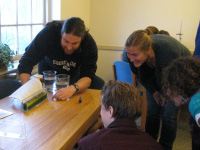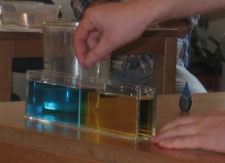 |
|
|
| SEARCH | CLASSROOM RESOURCES | |||||||||||||||||||||||||||||||||||||||||||||||||
|
Teacher: Tracy Vassiliev
Together, this group taught an experimental unit on rocketry to supplement the curriculum the students were already working with, a unit
focusing on pressure and related forces using rocketry and the book October Sky. This exercise was broken up into two labs that the grad students
worked closely with Tracy on to develop.Graduate Students: Noah and Mark The first lab had students designing and building their rockets while at the same time, developing hypotheses about what might happen. The second lab involved building chemically fuelled rockets, demonstrating the science behind chemical reactions and related forces. Teacher: Jesse DePue
On their initial visits to Jesse's three Grade 8 physical science classes and one 7th grade life science class, they both spent time introducing
themselves and how they got into the field of marine science. They then gave brief PowerPoint presentations explaining their current research.Graduate Students: Nick and Melissa During their later visits, they taught students the concepts of density and ocean acidification using a PowerPoint presentation and a laboratory activity. For the topic of ocean density, Nick and Melissa had students:
On the topic of ocean acidification, Nick and Melissa discussed with students what ocean acidification was, asking questions like, "What is pH?" and "What makes something more acidic?" to guide the class towards increased understanding of how things like a changing climate can affect ocean acidification. During the PowerPoint lecture, they conducted a number of pH-related demonstrations and had students follow along by completing an "Acids/Bases: Learning about pH" worksheet that reinforced the idea that varying pH levels can have an impact on ocean ecosystems. Ocean Acidification (DOCX, 52KB) and Learning About pH (DOCX, 16KB) worksheets2 Teacher: Patricia (Tricia) Bernhardt
When visiting Tricia's classrooms, these grad students focused on biological oceanography. Before diving into classroom activities, the grad
students began with brief talks about their current research (spiny dogfish and phytoplankton). They were then able to spend the rest of
class helping Tricia's students identify phytoplankton samples from the Gulf of Maine as part of a classroom activity.Graduate Students: Jeff, Mike, and Karen Plankton Activities (DOC, 40KB)3 Common Gulf of Maine Phytoplankton (PDF, 5.6MB)3 Plankton Identification Chart (PDF, 340KB)4 During follow-up visits, the grad students had Tricia’s class participate in a "Foraging and Adaptation" game, the objective of which was to demonstrate to students how adapations in species are the result of competition and often increase rates of survival. Teacher: Anne Mourkas
Graduate Students: Ali and Kerstin
References 1 Teaching Physical Concepts in Oceanography: An Inquiry Based Approach 2 Understanding Ocean Acidification 3 Great Bay Coast Watch 4 Catalina Island Marine Institute |
|||||||||||||||||||||||||||||||||||||||||||||||||
|
|||||||||||||||||






